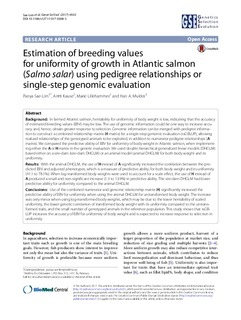| dc.description.abstract | Background In farmed Atlantic salmon, heritability for uniformity of body weight is low, indicating that the accuracy of estimated breeding values (EBV) may be low. The use of genomic information could be one way to increase accuracy and, hence, obtain greater response to selection. Genomic information can be merged with pedigree information to construct a combined relationship matrix (HH matrix) for a single-step genomic evaluation (ssGBLUP), allowing realized relationships of the genotyped animals to be exploited, in addition to numerator pedigree relationships (AA matrix). We compared the predictive ability of EBV for uniformity of body weight in Atlantic salmon, when implementing either the AA or HH matrix in the genetic evaluation. We used double hierarchical generalized linear models (DHGLM) based either on a sire-dam (sire-dam DHGLM) or an animal model (animal DHGLM) for both body weight and its uniformity. Results With the animal DHGLM, the use of HH instead of AA significantly increased the correlation between the predicted EBV and adjusted phenotypes, which is a measure of predictive ability, for both body weight and its uniformity (41.1 to 78.1%). When log-transformed body weights were used to account for a scale effect, the use of HH instead of AA produced a small and non-significant increase (1.3 to 13.9%) in predictive ability. The sire-dam DHGLM had lower predictive ability for uniformity compared to the animal DHGLM. Conclusions Use of the combined numerator and genomic relationship matrix (HH) significantly increased the predictive ability of EBV for uniformity when using the animal DHGLM for untransformed body weight. The increase was only minor when using log-transformed body weights, which may be due to the lower heritability of scaled uniformity, the lower genetic correlation of transformed body weight with its uniformity compared to the untransformed traits, and the small number of genotyped animals in the reference population. This study shows that ssGBLUP increases the accuracy of EBV for uniformity of body weight and is expected to increase response to selection in uniformity. | |
